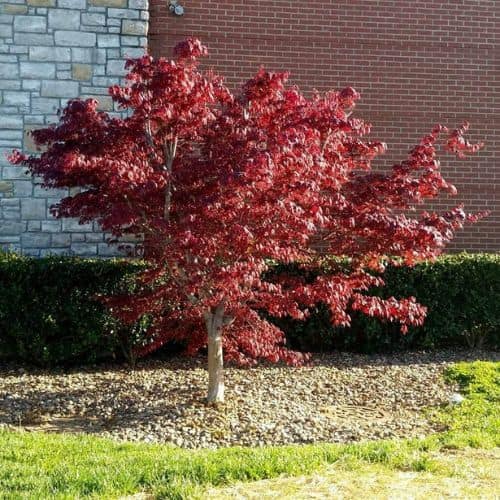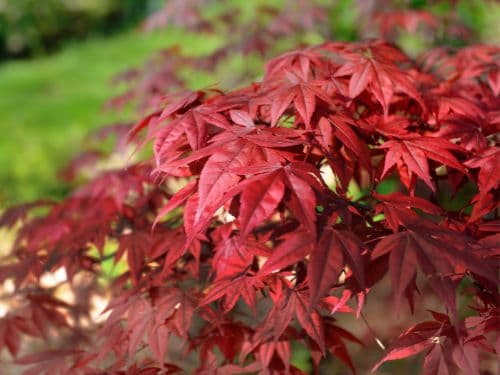Japanese Maple Trees are native to Japan, Korea, & China and are known for their beautiful foliage and graceful shape. These trees typically grow between 15 and 25 feet tall, though some varieties can grow much larger. Japanese Maples make excellent focal points for gardens and are often used to add color and texture to larger landscaping schemes.

Growing & Caring For Japanese Maples
Japanese Maples thrive in well-drained soil that is rich in organic matter. A slightly acidic to neutral pH is preferable. Additionally, they benefit from a location with dappled sunlight or partial shade, as too much direct sun can scorch their delicate foliage. Proper care for Japanese maples involves consistent watering, especially during dry spells. Mulching around the tree’s base helps retain soil moisture and regulates temperature, promoting a healthy root system.
Pruning is another crucial aspect of maintenance. Regularly remove any dead or diseased branches to enhance air circulation and prevent the onset of fungal diseases. Strategic pruning can shape the tree and showcase its unique branching structure. We advise pruning Japanese maples during late fall or winter when the tree is dormant.
Fertilizing Japanese maples is essential for encouraging vigorous growth and vibrant foliage. Use a balanced, slow-release fertilizer in early spring before new growth emerges. Avoid excessive use of nitrogen, as it can lead to leggy growth and diminish the intensity of leaf color. Consider protecting the tree during harsh winters in colder climates by wrapping the trunk with burlap or applying a layer of mulch around the base.
Varieties of Japanese Maples
There are many different varieties of Japanese maples, each with its own unique features. Some of the most popular varieties include the Acer palmatum, which has delicate, finely-lobed leaves that turn a bright red or orange in the fall, and the Acer japonicum, which has broader, more rounded leaves that turn a deep red in the fall. Other popular varieties include the Acer shirasawanum, which has beautiful golden-yellow leaves, and the Acer buergerianum, which has a more upright growth habit.
Leaves and Branches
One of the most notable features of Japanese maples is their leaves. They are generally small and delicate and come in various colors, including green, red, orange, and even purple. Some varieties have variegated leaves, with multiple colors on a single leaf. The unique leaves are also deeply lobed, giving them a feathery, delicate appearance. Another distinctive feature of Japanese maples is their branching structure. The branches are often twisted and gnarled, giving the tree a sense of age and character. The trees also tend to grow in a cascading, weeping shape, which adds to their elegance and beauty.

Uses in the Garden
One popular use for Japanese Maples is as a focal point or centerpiece, where the tree’s unique form and vibrant foliage draw the eye and create a visually stunning focal point. Placing a Japanese maple near a garden entrance, on a lawn, or at the center of a carefully designed landscape bed allows it to command attention and serve as a captivating element in the overall garden design.
Another effective way to incorporate Japanese maples into the garden is by using them as accent plants in mixed borders or alongside other ornamental shrubs and perennials. Their diverse leaf colors and textures complement a wide range of companion plants, providing a harmonious and visually appealing combination. When strategically placed, Japanese maples can add depth and interest to garden beds, creating a dynamic and ever-changing display throughout the seasons.
Frequently Asked Questions
Can I Transplant A Japanese Maple In The Spring?
Transplanting a Japanese maple tree in the spring is not recommended, as it can be stressful for the tree. The ideal time to transplant a Japanese maple is during the tree’s dormant season, typically in late fall to early winter or early spring before new growth begins. During these times, the tree is not actively growing, making it more resilient to the shock of transplanting.
How Much Water Do Japanese Maples Need?
Once established, Japanese maple trees generally have moderate water needs. They prefer consistently moist, well-draining soil. Water deeply once or twice weekly during dry periods, providing enough water to saturate the root zone thoroughly. However, newly planted or young Japanese maple trees may require more frequent watering to help them establish their root systems. Water them deeply and regularly, keeping the soil moist but not waterlogged.
Japanese maple trees may require more frequent watering during hot weather or drought to prevent stress and dehydration. Be attentive to signs of wilting or drooping leaves, which can indicate that the tree needs more water.
